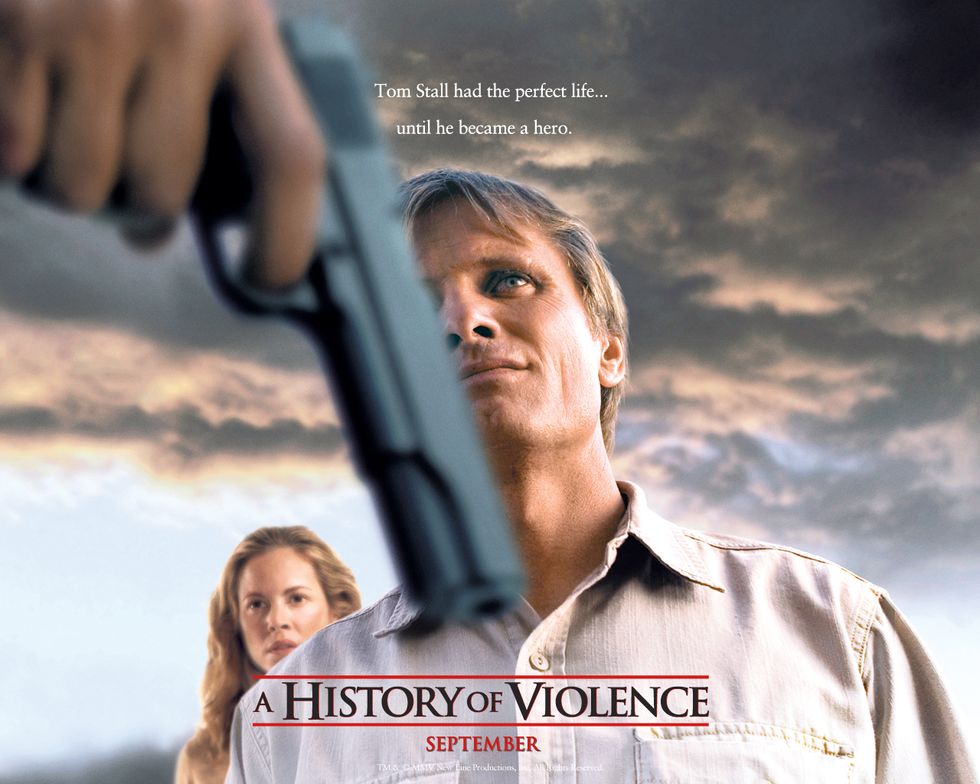This film has no political undertone, rather the point is to manifest violence into flesh-and-blood forms. The characters serve the purpose of illustrating violence. It can be abused for personal gain or used for good. What this film does is bring such an idea into a small town in America to challenge how people truly know each other.
Plot
The film begins with Tom Stall, who owns a diner and leads an ordinary life with his wife and two children. However, I didn't think the part with the cheerleader and bad boy role-playing was really needed, since it served a meager bit of symbolism that halted the plot. One day, his life changes when two men attempt to rob his diner and he kills them in self-defense. As the film progresses, a lot of tension builds in regards to who Tom really is, to the point when his own family is confused about who his identity.
Characters
Tom Stall's position in the film is to illustrate that even an honest, hard-working citizen living in the heart of America can be susceptible to violence. Although I liked Viggo Mortenson's portrayal of Tom Stall. If it isn't the fact that he's constantly being stalked, the very facial features that he uses challenges what we really know about Tom. I couldn't say the same about his Philly accent. He spoke with such a low volume, so low I did not even know he was trying to put off an accent.
When his wife asks what kind of a name is Stall, Tom says that it was the only one available. So that's supposed to be a toilet joke? He decided to pick the only name left and it was a stall? That part I didn't get. Plus, if was the only name left, wouldn't have been easier for Fogarty to track him down?
His wife (played by Maria Bello) was a little over-the-top at one point. It was a little unexpected when she threw up in the bathroom. Even in the Director's Commentary with David Cronenberg, he said that was not in the script, but they decided to add it anyway.
I liked Jack Stall. He used his intelligence to avoid getting beaten, by feeding the jock's ego. It wasn't until the breaking point at the diner when Jack begins to develop. However, after that, I lost favor with him, since his dialogue became annoyingly cringy.
Carl Fogarty. Truly Ed Harris becomes the personification of all creepiness in this film. His existence is truly the breaking point of the film and really makes us question who Tom really is.
Features
In David Cronenberg's director commentary, he commented how the setting actually took place in Canada. I never would've thought of that, because there is that sense of familiarity tied to small town America, such as the diner, small businesses, town center, and a bar, that made it believable. I did think that it was resourceful for his paying attention to detail.
The film is about violence, but I felt like it was hit or miss. Cronenberg mentioned in the Director's Commentary how he studied DVD's that instructed things like "How to Kill" and how they involved very awkward, brutal fighting. I definitely could see that he did his homework with Tom's action, which looked pretty raw. Not only did he use his own hands, but also whatever object or weapon was at his disposal. I also liked how he immediately and unexpectedly snaps into action in a split second, with the shortening of the length of the cinematic shots to create the illusion of fast action.
However, when Tom gets into his mode, it's almost like everyone else has their backs turned coincidentally and are very slow to react. This could lead the viewer to shout "HOW do you f*ck that up?!"
8/10
Violence is transmitted if not inherited through society and culture. It doesn't take sides. Sometimes it's used as a defensive mechanism, while other times it's used to gain power and supremacy. This is definitely a film that brings about the worst in humanity and puts into question who people really are. This is personally one of my favorite movies that I give a fair grade.




 man making a coffee lattePhoto by
man making a coffee lattePhoto by  Photo by
Photo by  Photo by
Photo by  Photo by
Photo by 









 Photo by
Photo by 











